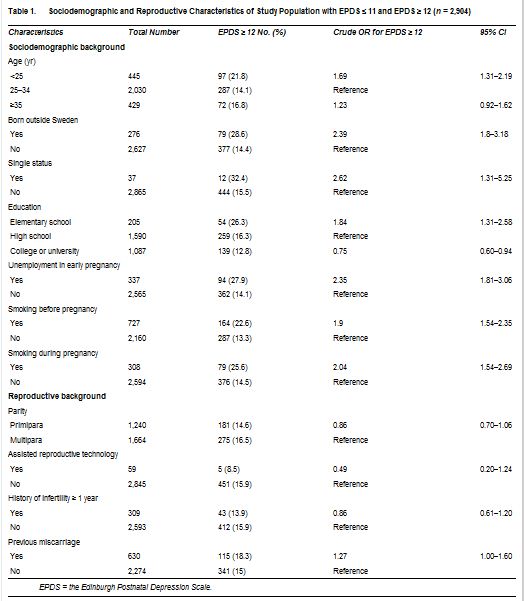Depression and Preterm Birth: The Evidence Grows
By: Walker Karraa, PhD | 0 Comments
Preterm birth estimates are 5-13% and the principal cause of morbidity and mortality for newborns1. 70% of spontaneous preterm births occur with preterm labor and preterm prelabor rupture of fetal membranes2. While medical science continues to examine diagnostic and treatment protocol, the etiology of preterm delivery is still unknown2. A 2009 collaborative paper between ACOG and the APA noted that 14% to 23% of pregnant women experience depression or anxiety in pregnancy, and that in 2003 13% of pregnant women took an antidepressant during pregnancy 3. There is a growing body of evidence demonstrating a relationship between depression and an increased risk of preterm birth.4,5,6,7,8
Featured Study:
Antenatal Depressive Symptoms and Preterm Birth: A Prospective Study of a Swedish National Sample9 offers a study with a large sample size, well-validated screening tool, and solid statistical data analysis. The conclusion: "Pregnant women reporting antenatal depressive symptoms are at elevated risk of preterm birth."
Participants:
The Swedish Medical Birth Register (SMBR) provided the ability to track gestational length for 2,904 women from their first prenatal visit to birth. The average gestational age at time of recruitment was 16 weeks. Of the 608 prenatal clinics in Sweden, authors received a 97.5% (n=593) participation rate. 5,150 women were assessed for eligibility; 4,600 women designated eligible. Of that group, 3,113 women signed informed consent; 3,061 women were enrolled in study, and authors received 2,904 completed questionnaires.
Variables and Screening:
The outcome variable, preterm birth, was defined as delivery prior to 37 weeks gestation. Depressive symptoms as a predictor variable were scored using the Edinburgh Post-natal Depression Scale (EPDS) 10. The EPDS is the gold standard, self-reporting scale for sensitivity and specificity for depressive symptoms as listed in the Diagnostic and Statistical Manual of Mental Disorders11. Usually, a cutoff score of ≥15 is used, but in comparison to two other Swedish studies using a lower cutoff (≥10), the authors used a ≥12 cutoff to most accurately validate the Swedish population.
Analysis:
With the assistance of the SPSS12, authors applied multiple logistic regression, and bivariate analyses. Results demonstrated an estimated risk of preterm birth, for women who had antenatal depressive symptoms of a score of ≥12 on EPDS, as significantly increased: (OR 1.56; 95% CI: 1.03-2.35). The risk is threefold among young women (<25 years old).

Authors reiterated current understanding of possible underlying factors "behind depressive symptoms" including increased inflammation in pregnancy leading to preterm birth13,14,15 and increased HPA activity resulting in over production of cortisol, leading to preterm birth16.
Conclusion:
What is stunning here is that even moderate levels of depressive symptoms (≥12) elevate the risk of preterm birth. And that the risk is much greater for women younger than 25. Clearly the relationship between depression and inflammation, and HPA axis-overdrive will offer future insight into the etiology of preterm birth, and shed light on the reproductive biology of depression/anxiety.
We incorporate evidence-based research regarding risks of pre-term birth in our childbirth classes: prenatal vitamins, exercise, smoking cessation, pre-eclampsia, and nutritional guidelines are covered. Are we covering depression/anxiety in pregnancy? Are we training the next generation of childbirth educators and doulas about screening, symptoms, risk factors, and effects of this major pregnancy complication (as listed by March of Dimes)? What might be most important, are we supporting those who ask for assistance in bringing this to the forefront of maternal health advocacy? This study is yet another demonstration of the need for increased awareness of the effects of untreated perinatal mental health. Just as we use evidence to support our advocacy of natural birth, and VBAC, why not mental health - when it is demonstrated over and over to be a risk factor for preterm birth?
Universal screening for perinatal depression/anxiety is happening, with ACOG & AAP recommendations and practices in place. I would like to suggest that the universe includes childbirth educators and doulas - and we should claim our rightful place at the table and begin to participate in this matter as first responders.
If not now, when? And on a deeper level, why not?
For more information regarding the role of inflammation and HPA, I highly recommend the work of Michael Lu, MD, MPH http://www.harpercollins.com/author/microsite/about.aspx?authorid=35261
Get Ready to Get Pregnant: Your Complete Pre-Pregnancy Guide to Making a Smart and Healthy Baby
Posted by: Walker Karraa, MFA, CD (DONA)
[Editor's note: Go here to read a related article, posted this week on MSNBC.com regarding antenatal depression and its effects on mom and baby.
For references pertaining to Ms. Karraa's post, go here: References_walker_antenatal depression and preterm birth post.]
Published: April 20, 2011
Tags
PostpartumSensibility